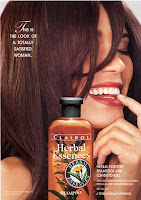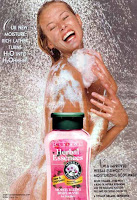Tuesday, April 24, 2007
Sunday, April 22, 2007
Blog Critique
Michelle's Comments for My blog:
My Comments for Michelle's Blog :
1. Your posts on “Commercials in the News” and “The Conflict of Appearance in Women through Commercials” are a very strong and analytical and provide very insightful and useful information in viewing commercials and advertisements.
2. A good way to use these post for your final blog post would be to make a timeline on how images of women (and/or men) have changed since commercials were first aired to today’s average commercial. You could also use the video blogging as an extra oomph to your final blog assignment.
3. It is obviously evident that you feel strongly about what you write about and I can see how your blog as evolve from your first “Links about my Blog” to “Commercials in the News” and can also be a great idea for your final blog presentation.
4. I think that your posts make strong critical arguments on how gender is depicted in your everyday commercial and how ignorant people are to the stereotypes that are unconsciously engraved in these commercials. I also appreciate how the links and sources you use help the reader become more identified to the argument you are making.
5. I thought it was great how you observed and analyze the Snickers Commercial. Your argument really made me angry in the sense that I wanted to send the company a letter ...even though they probably stopped airing the commercial by now. J
Hope this helped!!
My Comments for Michelle's Blog :
1. Your posts on “Commercials in the News” and “The Conflict of Appearance in Women through Commercials” are a very strong and analytical and provide very insightful and useful information in viewing commercials and advertisements.
2. A good way to use these post for your final blog post would be to make a timeline on how images of women (and/or men) have changed since commercials were first aired to today’s average commercial. You could also use the video blogging as an extra oomph to your final blog assignment.
3. It is obviously evident that you feel strongly about what you write about and I can see how your blog as evolve from your first “Links about my Blog” to “Commercials in the News” and can also be a great idea for your final blog presentation.
4. I think that your posts make strong critical arguments on how gender is depicted in your everyday commercial and how ignorant people are to the stereotypes that are unconsciously engraved in these commercials. I also appreciate how the links and sources you use help the reader become more identified to the argument you are making.
5. I thought it was great how you observed and analyze the Snickers Commercial. Your argument really made me angry in the sense that I wanted to send the company a letter ...even though they probably stopped airing the commercial by now. J
Hope this helped!!
Thursday, April 12, 2007
“News and Gender” in Advertisements: Fashion Ads Touch a Nerve in Gender-conscious Spain
This news article by Victoria Burnett, issued from the International Herald Tribune, entitled Fashion Ads Touch a Nerve in Gender-conscious Spain is about how Spain is taking the initiative to ban and prohibit gender stereotypes in advertisements and fashion clothing stores.
The article mentions Jose Luis Rodriguez Zapatero and his government on how they are intervening in “public and commercial life to try to change Spain’s macho culture” that seems to continue to oppress women.
As mentioned my Burnett, certain Giorgio Armani and Dolce & Gabbana advertisements deemed as sexists toward women and have disturbed society, especially Spanish women consumers. One particular advertisement that showed two girls with makeup and bikinis disturbed Madrid’s ombudsman saying that “It’s not dissimilar to the pictures that circulate on the Internet promoting sex tourism.”
Burnett also mentions in the article that due to these female gender stereotypes, the Spanish Health Ministry has campaigned to measure 8,000 women for a better ideal on the “average” women’s size for clothing and mannequins in top Spanish fashion companies.
The article mentions Jose Luis Rodriguez Zapatero and his government on how they are intervening in “public and commercial life to try to change Spain’s macho culture” that seems to continue to oppress women.
As mentioned my Burnett, certain Giorgio Armani and Dolce & Gabbana advertisements deemed as sexists toward women and have disturbed society, especially Spanish women consumers. One particular advertisement that showed two girls with makeup and bikinis disturbed Madrid’s ombudsman saying that “It’s not dissimilar to the pictures that circulate on the Internet promoting sex tourism.”
Burnett also mentions in the article that due to these female gender stereotypes, the Spanish Health Ministry has campaigned to measure 8,000 women for a better ideal on the “average” women’s size for clothing and mannequins in top Spanish fashion companies.
Wednesday, April 11, 2007
Why Gender in Ads? What My Blog is Really About...
My blog is about the daily advertisements that are socially constructing the images and ideas of gender while being portrayed through the media. In this blog I will compare and contrast the gender representations that the media displays through these advertisements. At first I only started this blog simply because it was a course requirement for my class Gender and Pop Culture. However, being that I am very interested in what advertisements have to say about the way people should live (what's in and what's not), I chose this topic for my blog because I want to reflect on the everyday gender stereotypes that people do not normally see because they are blinded by the clichés of society.
As obvious as it truly is, advertisements are everywhere and used to each companies advantage. Most advertisements are well thought out and planned to enhance the companies profits and publicity; even if that means having to break a few backs (or say perhaps innocent minds) just to make a million dollars. However, it's not the adults or elderly that are mainly affected by these gender stereotypes, it's the children and teens that are looking to these images in determining their own identity, i.e., sex, nymphomania, women consumers. In his article, Cultural Studies, Multiculturalism, and Media Culture, Douglas Kellner states “Media Culture provides the materials for constructing views of the world, behavior, and even identities. Those who uncritically follow the dictates of media culture tend to ‘mainstream’ themselves, conforming to the dominant fashion, values, and behavior”. The young people of today are the ones who are “tending” to materials given by these gender stereotypes in advertisements, showing them what to look like, how to dress, and how to behave.
Many advertisements, such as Herbal Essence, demonstrate women and femininity as a symbol of chaste sexuality; in other words, nymphomania. Some advertisements show women having orgasmic reactions to simple hair and body wash. For example, one slogan for Herbal Essence body wash says “Our New Moisture-Rich Lather Turns H2O into H2Ohhhh!” This also shows a half naked woman, only covering her breasts and vagina, which appears to show the woman as happily laughing and enjoying the body wash. Another Herbal Essence advertisement for hair wash shows a woman with a big smile, finger in her mouth, hair over her face, and eyes closed. The slogan for this particular advertisement says “This is the look of a totally satisfied woman.” What are these advertisements really saying to young people? Is this sending out a negative message, that women are clueless nymps who have orgasms to body wash and shampoo? Need I say anything else?
What is most important is who is looking at these advertisements. Consequently, if every little person is looking to these images then society will not progress in changing the minds of people who unconsciously stereotype gender; scholars, professors, and college students alone can not stop these stereotypical images. (These are the kind of issues in advertisements that I will be addressing in my blog.)
Kellner, Douglas. "Cultural Studies, Multiculturalism, and Media Culture." Gender, Race, and Class In Media (2003): 9-19.


Thursday, April 5, 2007
How To Read Ads.... See What I See? (thanks to research team)
Here is an excerpt from GenderAds.com  on how to read and go about analyzing gender in ads portraying male and/or female in a negative light. There are six ares/levels of analysis in looking at ads. Enjoy... :o)
on how to read and go about analyzing gender in ads portraying male and/or female in a negative light. There are six ares/levels of analysis in looking at ads. Enjoy... :o)
Area I: Basic Analysis of the Layers of Meaning in Ads
[Katherine Frith (1998)] discusses a tripartite approach to reading advertising. The examples below follow her understandings of ads in "Undressing the Ad: Reading Culture in Advertising.
Area II: Semiotic Analysis of Ads
Erving Goffman's classic Gender Advertisements (1979) offers a semiotic analysis of advertising. Goffman's analysis looks at the specific codes present in ads and considers what they say about society and social relationships. His study includes a focus on minute details of ads, visual composition of ads, as well as the presence of specific social themes in ads.
Area III: Thematic Analysis of Ads
In Advertising and the End of the World director Sut Jhally focuses on the negative impacts of advertising on our social relations and the environment. He develops a specific analysis of ads that draws the viewer to make holistic conclusions about the totality of the advertising industry. This holistic approach includes considerations of how a majority of ads stress specific visions of society, focus on how products produce happiness in consumers and project a vision of the future. Thus, another way to read ads is to consider the themes that develop in a specific medium, such as a Vogue magazine, or across a number of issues of that magazine or even across a broad spectrum of multiple magazines. This web page is focused on this holistic analysis of the themes that appear in popular advertisements. Jhally's other significant work, Dreamworlds II, also influenced a number of the themes that can be found in both music videos and popular magazine ads.
Area IV: Quantitative Analysis of Ads
Quantitative analyses of ads focus on the number of ads that represent a particular theme in the study. For example, one might conduct an analysis of the various forms of representation, techniques of presentation and thematic issues present in male and female sports magazines. A quantitative assessment of the numbers of any of these items would give a relative indication of the social constructions present in the advertising.
Area V: Side-By-Side Comparisons of Ads
This approach to ads would use two or more ads in a comparative sense to understanding differences in the constructions of gender and sexuality in ads. A goal of this form of analysis is to understand content and thematic differences in visual representations.
Area VI: Ethnographic Analysis of Ads
An ethnographic analysis of ads would include (1) interviews with ad or media agency representatives as to the goals of their advertising campaigns, (2) interviews with everyday individuals to assess their understandings of the meanings of ads.
 on how to read and go about analyzing gender in ads portraying male and/or female in a negative light. There are six ares/levels of analysis in looking at ads. Enjoy... :o)
on how to read and go about analyzing gender in ads portraying male and/or female in a negative light. There are six ares/levels of analysis in looking at ads. Enjoy... :o)Area I: Basic Analysis of the Layers of Meaning in Ads
[Katherine Frith (1998)] discusses a tripartite approach to reading advertising. The examples below follow her understandings of ads in "Undressing the Ad: Reading Culture in Advertising.
Area II: Semiotic Analysis of Ads
Erving Goffman's classic Gender Advertisements (1979) offers a semiotic analysis of advertising. Goffman's analysis looks at the specific codes present in ads and considers what they say about society and social relationships. His study includes a focus on minute details of ads, visual composition of ads, as well as the presence of specific social themes in ads.
Area III: Thematic Analysis of Ads
In Advertising and the End of the World director Sut Jhally focuses on the negative impacts of advertising on our social relations and the environment. He develops a specific analysis of ads that draws the viewer to make holistic conclusions about the totality of the advertising industry. This holistic approach includes considerations of how a majority of ads stress specific visions of society, focus on how products produce happiness in consumers and project a vision of the future. Thus, another way to read ads is to consider the themes that develop in a specific medium, such as a Vogue magazine, or across a number of issues of that magazine or even across a broad spectrum of multiple magazines. This web page is focused on this holistic analysis of the themes that appear in popular advertisements. Jhally's other significant work, Dreamworlds II, also influenced a number of the themes that can be found in both music videos and popular magazine ads.
Area IV: Quantitative Analysis of Ads
Quantitative analyses of ads focus on the number of ads that represent a particular theme in the study. For example, one might conduct an analysis of the various forms of representation, techniques of presentation and thematic issues present in male and female sports magazines. A quantitative assessment of the numbers of any of these items would give a relative indication of the social constructions present in the advertising.
Area V: Side-By-Side Comparisons of Ads
This approach to ads would use two or more ads in a comparative sense to understanding differences in the constructions of gender and sexuality in ads. A goal of this form of analysis is to understand content and thematic differences in visual representations.
Area VI: Ethnographic Analysis of Ads
An ethnographic analysis of ads would include (1) interviews with ad or media agency representatives as to the goals of their advertising campaigns, (2) interviews with everyday individuals to assess their understandings of the meanings of ads.
Subscribe to:
Posts (Atom)



